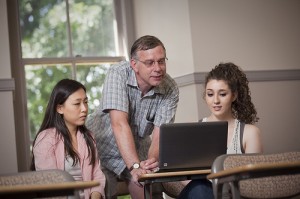
Liusha Geng ’13 (left) works with Professor Robert Root and Heidi Verheggen ’12.
Forget Shark Week on the Discovery Channel. When Rob Root and his research assistants watch videos of sharks swimming, they are looking for clues to help determine how–and why–fish and other vertebrates developed backbones.
It sounds like a problem more suited to study by a biologist, but Root, associate professor of mathematics, and his team use complex math to model the motions of swimming fish as part of an ongoing project to study how vertebrae first evolved. The work is supported by a $956,000 grant that Root and Chun Wai Liew, associate professor and head of computer science, received from the National Science Foundation.
Most recently, Root has been assisted by EXCEL Scholars Heidi Verheggen ’12 (Zionsville, Pa.), and Liusha Geng ’13 (Xian, China), both of whom are mathematics-economics majors. Verheggen and Geng worked on statistical analysis of the undulatory (smooth and wavelike) motion of swimming fish.
“Because this motion is a repetitive wave, it is natural to use the basic mathematical tools used to study waves and repetitive phenomena,” Root says.
In an earlier phase of this research, Root studied steady swimming in fish. Verheggen and Geng spent the summer working on extending that research to unsteady motion like turns, starts, and stops.
That requires determining things like when the motion begins and ends. In analyzing one video of a shark swimming and turning, the team was able to calculate its velocity to determine that the shark actually begins its turning motion before it becomes apparent that it is turning. Root and his team focus their attention on sharks because their vertebral column, or backbone, is the simplest.
“The main goal of the research is to mathematically model the motion of a fish as it swims, and to design a mathematical model that can accurately describe various types of swimming, especially one that can handle the complexities involved in unsteady swimming. We want to have an accurate expression that can describe the various motions of a fish in order to better understand how the fish’s muscular, skeletal, and nervous systems contribute to these motions,” Verheggen says.
Her role was to apply a mathematical technique called the Hilbert transform to the data, and to manipulate this technique in various ways in order to extract as much information as possible about the fish’s movement. Liusha then used this information to bolster a model she built of the fish’s motion.
Verheggen says the experience has given her a new respect for interdisciplinary work. “It’s not just working with numbers. The numbers now have a meaning attached—they describe the complex details of a fish’s movement,” she says.
“In addition to realizing the importance of balancing the practical and theoretical, the project has helped me appreciate both my own major as well as other fields. I’ve sharpened my math and programming skills, but I’ve also gained a more intangible, and invaluable, asset: an appreciation of and a thirst for exploring other disciplines, and using those disciplines to broaden my own work,” she says.

1 Comment
Comments are closed.